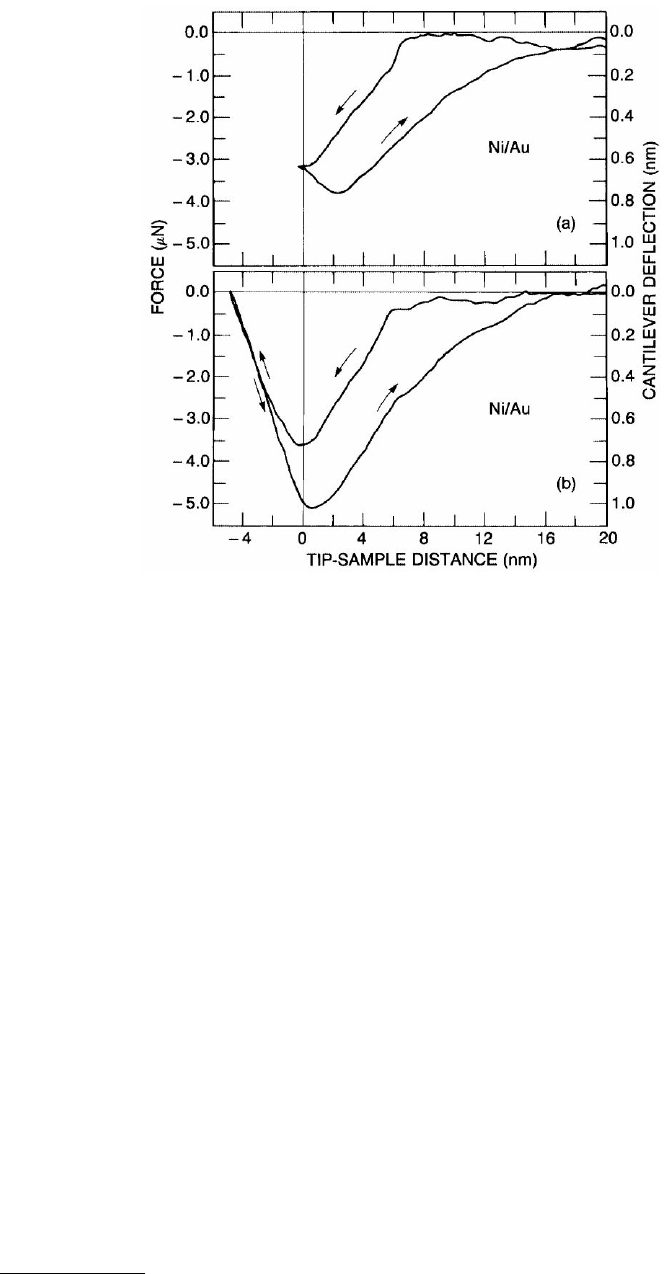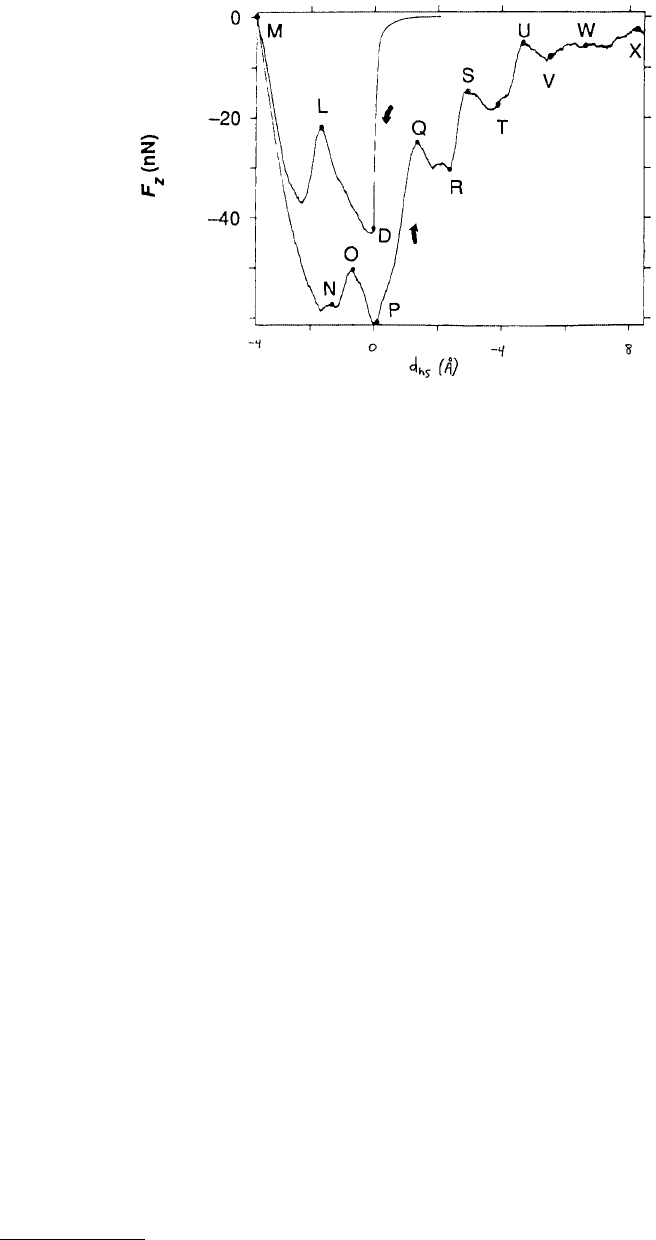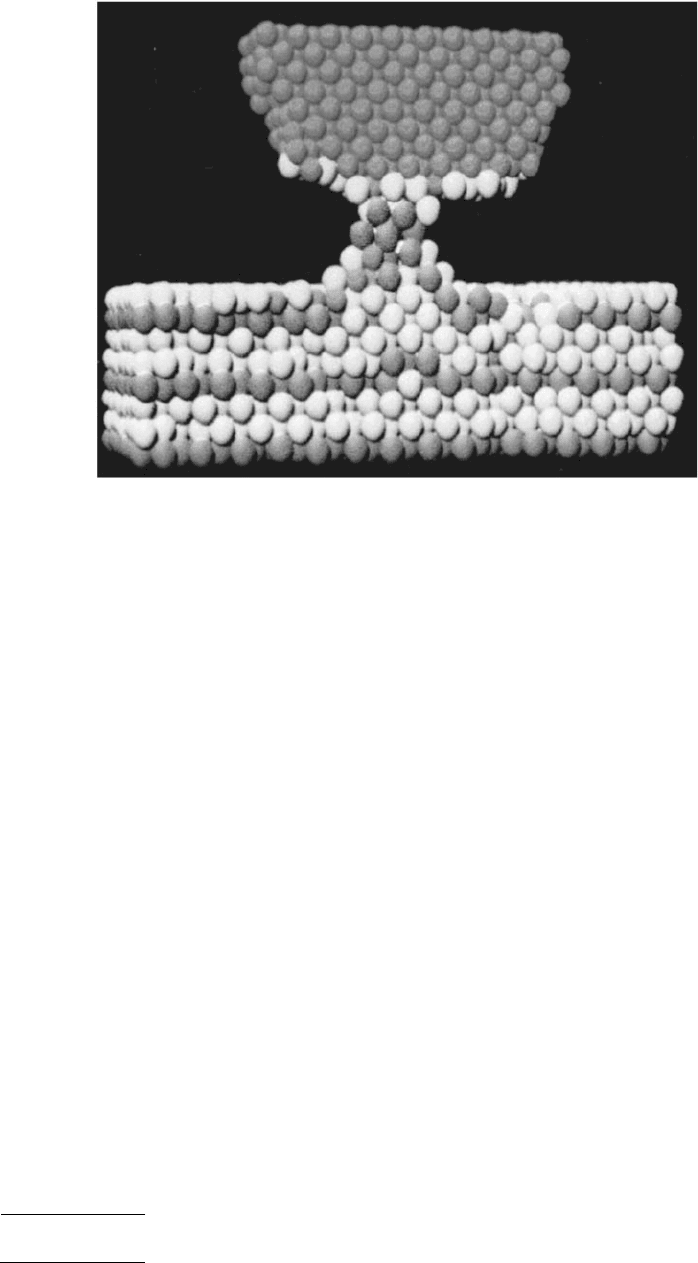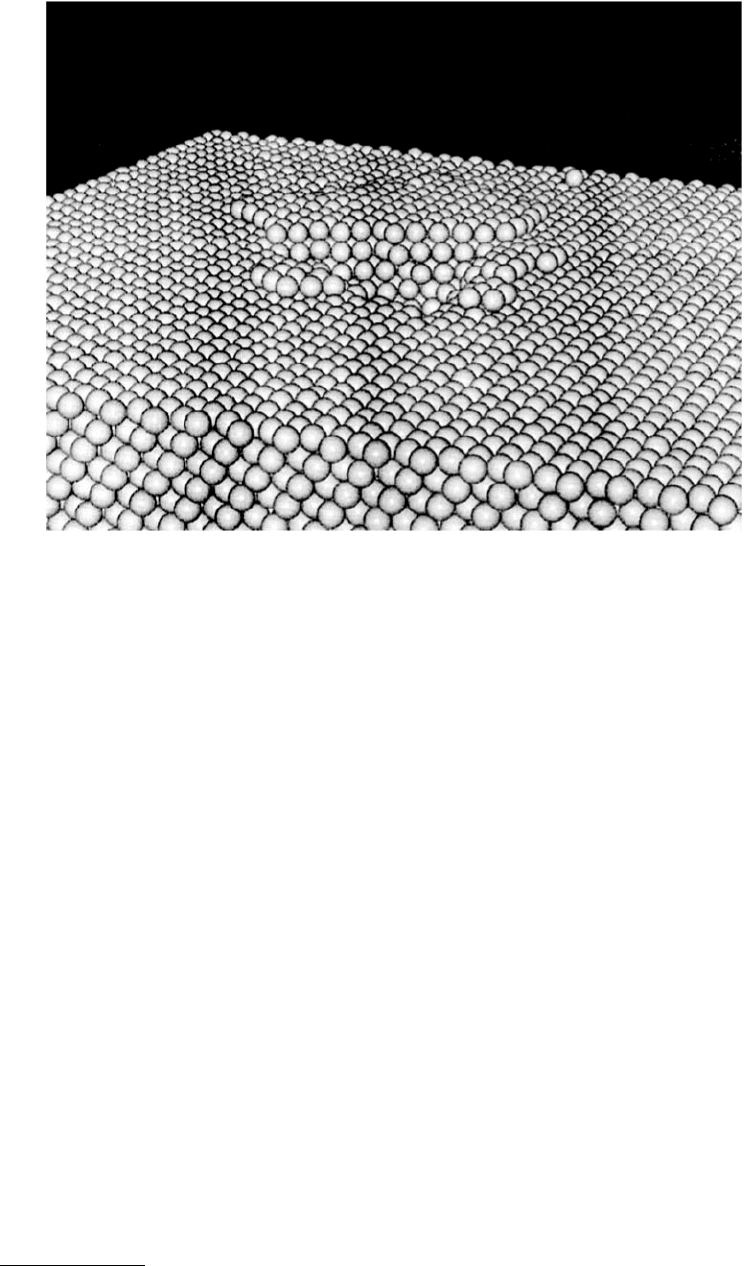Bhushan B. Handbook of Micro/Nano Tribology, Second Edition
Подождите немного. Документ загружается.


© 1999 by CRC Press LLC
continue to increase and as new algorithms are developed, we expect that these more exact methods will
play an increasingly important role in tribological simulations.
11.2.2 Thermodynamic Ensemble
When performing a MD simulation, a choice must be made as to which thermodynamic ensemble to
study. These ensembles are distinguished by which thermodynamic variables are held constant over the
course of the simulation. (For a broader and more rigorous treatment of ensemble averaging, the reader
should consult any statistical mechanics text, (e.g., McQuarrie, 1976)).
Without specific reasons to do otherwise, it is quite natural to keep the number of atoms (
N
) and the
volume of the simulation cell (
V
) constant over the course of a MD simulation. In addition, for a system
without energy transfer, integrating the equations of motion (Equation 11.1) will generate a trajectory
over which the energy of the system (
E
) will also be conserved. A simulation of this type is thus performed
in the constant-
NVE,
or microcanonical, ensemble.
Systems undergoing sliding friction or indentation, however, require work to be performed on the
system, which raises its energy and causes the temperature to increase. In a macroscopic system, the
environment surrounding the region of tribological interest acts as an infinite heat sink, removing excess
energy and helping to maintain a fairly constant temperature. Ideally, a sufficiently large simulation would
be able to model this same behavior. But while the thousands of atoms at an atomic-scale interface are
within reach of computer simulation, the
O
(10
23
) atoms in the experimental apparatus are not. Thus, a
thermodynamic ensemble that will more closely resemble reality will be one in which the temperature
(
T
), rather than the energy, is held constant. These simulations are performed in the constant-
NVT,
or
canonical, ensemble.
A constant temperature is maintained in the canonical ensemble by using any of a large number of
thermostats, many of which are described in the following section. What is often done in simulations of
indentation or friction is to apply the thermostat only in a region of the simulation cell that is well
removed from the interface where friction is taking place. This allows for local heating of the interface
as work is done on the system, while also providing a means for efficient dissipation of excess heat. These
“hybrid”
NVE/NVT
simulations, although not rigorously a member of any true thermodynamic ensem-
ble, are very useful and quite common in tribological simulations.
A particularly troublesome system for MD simulations is the nonequilibrium dynamics of confined
thin films (see Section 11.4.2). In these systems, the constraint of constant atom number is not necessarily
applicable. Under experimental conditions, a thin film under shear or tension is free to exchange mole-
cules with a reservoir of bulk liquid molecules, and the total atom number is certainly conserved. But
the number of atoms in the film itself is subject to rather dramatic changes. According to some studies,
as many as half the molecules in an ultrathin film will exit the interfacial region upon a change in registry
of the opposing surfaces (i.e., with no change in interfacial volume) (Schoen et al., 1989). Changes in
the film particle number can be equally large under compression.
The proper conserved quantity in these simulations is not the particle number
N,
but the chemical
potential
µ
. During a simulation performed in the constant-
µ
VT,
or grand canonical, ensemble, the
number of atoms or molecules fluctuates to keep the chemical potential constant. A true grand canonical
MD simulation is too difficult to perform for all but the simplest of liquid molecules, however, due to
the difficulties associated with inserting or removing molecules at bulk densities. An alternative chosen
by some authors is to mimic the experimental reservoir of bulk liquid molecules on a microscopic scale.
This involves performing a constant-
NVT
(Wang et al., 1993a,b, 1994) or constant-
NPT
(Gao et al., 1997)
simulation that explicitly includes a collection of molecules that are external to the interfaces (see
Figure 11.14). As liquid molecules drain into or are drawn from the reservoir region, the number of
particles directly between the interfaces is free to change. This method is then an approximation to the
grand canonical ensemble when only a subset of the system is considered. Two drawbacks to this method
are that the interface can extend infinitely (via periodic boundary conditions) in only one dimension
instead of two, and also that a significant number of extraneous atoms must be carried in the simulation.

© 1999 by CRC Press LLC
An interesting alternative to the grand canonical ensemble is that chosen by Cushman and co-workers
(Schoen et al., 1989; Curry et al., 1994). They performed a series of grand canonical Monte Carlo
simulations at various points along a hypothetical sliding trajectory. These simulations were used to
calculate the correct particle numbers at a fixed chemical potential, which were in turn used as inputs
to nonsliding, constant-
NVE
MD simulations at each of the chosen trajectory points. Because the system
was fully equilibrated at each step along the sliding trajectory, the sliding speed can be assumed to be
infinitely slow. This offers a useful alternative to continuous MD simulations, which are currently
restricted to sliding speeds of roughly 1 m/s or greater — orders of magnitude larger than most experi-
mental studies.
11.2.3 Temperature Regulation
As was discussed in the previous section, some method of controlling the system temperature is required
in simulations involving friction or indentation. In this section, we discuss some of the many available
thermostats that are used for this purpose. For a more formal discussion of heat baths and the trajectories
that they produce, the reader is referred to Hoover (1986).
The most straightforward method for controlling heat production is simply to rescale intermittently
the atomic velocities to yield a desired temperature (Woodcock, 1971). This approach was widely used
in early MD simulations, and is often effective at maintaining a given temperature during the course of
a simulation. However, it has several disadvantages that have spurred the development of more-sophis-
ticated methods. First, there is little formal justification. For typical system sizes, averaged quantities,
such as pressure, do not correspond to those obtained from any particular thermodynamic ensemble.
Second, the dynamics produced are not time reversible, again making results difficult to analyze in terms
of thermodynamic ensembles. Finally, the rate and mode of heat dissipation are not determined by system
properties, but instead depend on how often velocities are rescaled. This may influence dynamics that
are unique to a particular system.
A more-sophisticated approach to maintaining a given temperature is through Langevin dynamics.
Originally used to describe Brownian motion, this method has found widespread use in MD simulations.
In this approach, additional terms are added to the equations of motion, corresponding to a frictional
term and a random force (Schneider and Stoll, 1978; Hoover, 1986; Kremer and Grest, 1990). The
equations of motion (see Equation 11.1) are given by
(11.9)
where
F
are the forces due to the interatomic potential, the quantities
m
and
v
are the particle mass and
velocity, respectively,
ξ
is a friction coefficient, and
R
(
t
) represents a random “white noise” force. The
friction kernel is defined in terms of a memory function in formal applications; kernels developed for
harmonic solids have been used successfully in MD simulations (Adelman and Doll, 1976; Adelman,
1980; Tully, 1980).
As with any thermostat, the atom velocities are altered in the process of controlling the temperature.
It is important to keep this in mind when using a thermostat, because it has the potential to perturb any
dynamic properties of the system being studied. To help avoid this problem, one effective approach is to
add Langevin forces only to those atoms in a region away from where the dynamics of interest occurs.
In this way, coupling to a heat bath is established away from the important action, and simplified
approximations for the friction term can be used without unduly influencing the dynamics produced by
the interatomic forces. For heat flux via nuclear (as opposed to electronic) degrees of freedom in solids,
it has been shown that a reasonable approximation for the friction coefficient
ξ
is 6/
π
times the Debye
frequency
β
(Adelman and Doll, 1976). Lucchese and Tully (1983) have shown that with this approxi-
mation and a sufficiently large reaction zone, the vibrational modes of atoms away from the bath atoms
are well described by the interatomic potential.
mmRtaF v== +
()
ξ ,

© 1999 by CRC Press LLC
The random force can be given by a Gaussian distribution where the width, which is chosen to satisfy
the fluctuation–dissipation theorem, is determined from the equation
(11.10)
The function
R
is the random force in Equation 11.9,
m
is the particle mass,
T
is the desired temperature,
k
is Boltzmann’s constant,
t
is time, and
ξ
is the friction coefficient. The random forces are uncoupled
from those at the previous steps (as denoted by the delta function), and the width of the Gaussian
distribution from which the random force is chosen depends on the temperature.
The simplified Langevin approach outlined above does not require any feedback from the current
temperature of the system; instead, the random forces are determined solely from Equation 11.10. A
slightly different expression has been developed that eliminates the random forces and replaces the
constant-friction coefficient with one that depends on the ratio of the desired temperature to current
kinetic energy of the system (measured as a temperature) (Berendsen et al., 1984). The resulting equations
of motion are
(11.11)
where
F
is the force due to the interatomic potential,
T
0
and
T
are the desired and actual temperatures,
respectively, and
v is again the particle velocity. The advantage of this approach is that it requires no
evaluation of random forces, which can be expensive for a large number of bath atoms. One disadvantage
in practice is that if the system is not pre-equilibrated to populate properly the vibrational modes, or if
nonrandom external forces are applied to the system, it can be slow to fully equilibrate the system. For
example, a simulated indentation of a solid surface requires that the bottom layers of the solid be held
rigid (Section 11.3). Compression of the surface during indentation may cause sound waves to propagate
into the bulk, reflect from the bottom layers, and continue to reflect between the surface and rigid layers.
Because the Berendsen thermostat uses a frictional force that depends on the average kinetic energy, it
would only reduce the total kinetic energy of the system, and not help dissipate a traveling wave. On the
other hand, the Langevin approach using a random force on each atom does not require feedback from
the system, and thermostats each atom individually. Thus, the random forces are much more efficient
in eliminating these nonphysical reflecting waves.
Nonequilibrium equations of motion have also been developed to maintain a constant temperature
(Hoover, 1986). Like the Berendsen thermostat, this approach adds a friction to the interatomic forces.
However, it is derived from Gauss’ principle of least constraint, which maintains that the sum of the
squares of any constraining forces on a system should be as small as possible. Using a Lagrange multiplier,
a frictional force on each atom i of the form
(11.12)
where
(11.13)
can be derived that maintains a constant temperature. The quantity m
i
is the mass of atom i, v
i
is its
velocity, and F
i
is the total force on atom i due to the interatomic potential. Note that there is no target
temperature in this expression; instead, the temperature of the system when the constraint is initiated is
R R t mkT t02
()
⋅
()
=
()
ξδ .
mm
T
T
aF v=+ −
ξ
0
1,
Fv
iii
m
friction
=−ς ,
ς= ⋅
()
()
∑∑
Fv v
ii
i
i
i
m
2
,

© 1999 by CRC Press LLC
maintained for all time. This approach has several obvious advantages. First, it does not rely on an
approximated input such as the Debye frequency as in the simplified Langevin or Berendsen thermostats.
Heat loss and gain are therefore determined only by implicit system properties. Second, because a random
force is not required, it does not significantly increase computational time. Third, the equations of motion
are time reversible. Finally, by differentiating total energy with respect to time, the heat loss (or gain)
due to the thermostat can be calculated directly (this is also true of the Langevin thermostat). However,
as with the Berendsen thermostat, coupling of the frictional to global properties of the system may be
slow to randomize nonphysical vibrational disturbances.
A thermostat that corresponds rigorously to a canonical ensemble has been developed by Nosé
(1984a,b). This significant advance also adds a friction term, but one that maintains the correct distri-
bution of vibrational modes. It achieves this by adding a new dimensionless variable to the standard
classical equations of motion that can be thought of as a large heat bath, which couples to each of the
physical degrees of freedom. The actual effect of the variable, however, is to scale the coordinates of either
time or mass in the system. The dynamics of the expanded system correspond to the microcanonical
ensemble, but when projected onto only the physical degrees of freedom they generate a trajectory in
the canonical ensemble. Sampling problems associated with very small or very stiff systems can be
overcome by attaching a series of these Nosé-Hoover thermostats to the system (Martyna et al., 1992).
The resulting equations of motion are time reversible, and the trajectories can be analyzed exactly with
well-established statistical mechanical principles (Martyna et al., 1992). For a complete description of
the Nosé thermostat, its relation to other formalisms for generating classical equations of motion, and
a comparison of the dynamics generated with this approach and the others that have been reviewed here,
the reader is referred to Hoover (1986).
Each of the potential energy functions, thermodynamic ensembles, and thermostats outlined above
has advantages and disadvantages. The optimum choice depends strongly on the particular system and
process being simulated as well as on the type of information in which one is interested. For example,
general principles related to liquid lubrication in confined areas may be most easily understood and
generalized from simulations that use pair potentials and may not require a thermostat. On the other
hand, if one wants to study the wear or indentation of a surface of a particular metal, then EAM or other
semiempirical potentials, together with a thermostat, may yield more reliable results. Even more-detailed
studies, including the evaluation of electronic degrees of freedom, may require interatomic forces derived
from some level of electronic structure calculation. The best way to make this choice is to understand
carefully the strong points of each of these approaches, decide what one wishes to learn from the
simulation, and form conclusions based on this careful understanding.
11.3 Nanometer-Scale Material Properties: Indentation,
Cutting, and Adhesion
Understanding material properties at the nanometer scale is crucial to developing the fundamental ideas
needed to design new coatings with tailor-made friction and wear properties. One of the ways in which
these properties is being characterized is through the use of the AFM. This technique is proving to be a
very versatile tool that can provide a rich variety of atomic-scale information pertaining to a given
tip–sample interaction (Burnham and Colton, 1993). For example, when an AFM tip (the radius of
curvature of AFM tips typically ranges from 100 Å to 100 µm) is rastered across a sample substrate and
the force on the tip perpendicular to the substrate is measured at each point, a force map of the surface
is obtained that can be related to the actual topography of the surface (Meyer et al., 1992). Rastering the
AFM tip across a substrate in the same way, but measuring the deflection of the tip in the lateral direction
instead, produces a friction map of the surface (Germann et al., 1993). Finally, by moving the tip
perpendicular to the surface of the substrate, the AFM can be used as a nanoindenter that probes the
mechanical properties of various substrates and thin films (Burnham and Colton, 1989; Burnham et al.,
1990).

© 1999 by CRC Press LLC
Adhesive contact can be examined by gradually moving the tip closer to the substrate until the two
come into contact. After contact, the tip is retracted from the surface, and any differences between the
force curves for contact and retraction reflect characteristics of adhesion. A plot of normal force on the
tip vs. tip–sample separation (i.e., a force curve) is typically made to record this sequence of events. A
force curve for the adhesive contact of a Ni tip with an Au substrate (denoted Ni/Au) is shown in
Figure 11.2a. This is a typical curve possessing the same qualitative features as most AFM force curves.
For instance, as the tip and the sample begin to interact, a small attractive well, due to long-range forces
(Burnham and Colton, 1993) is apparent in the force curve at large tip–sample separations (the well is
centered at a tip–sample separation of approximately 17 nm). The distance between the tip and the
sample is gradually decremented until the tip comes into contact with the sample. After contact the tip
is retracted, and adhesion between the tip and the substrate manifests itself as a hysteresis in the force
curve.
After contact, if the tip is moved farther toward the substrate, rather than away from the substrate,
indentation of the sample by the tip results. This indentation is reflected as a dramatic increase in force
as the tip is moved farther into the substrate (Figure 11.2b). This region of the force curve is known as
the repulsive wall region (Burnham and Colton, 1993), or when considered without the rest of the force
curve, an indentation curve. Retraction of the tip subsequent to indentation results in an enhanced
adhesion, therefore, in a larger hysteresis in the force curve. The origin of this enhanced adhesion is
discussed later.
Many types of adhesion at a tip–substrate interface are possible. Adhesion might result from the
formation of covalent chemical bonds between the tip and the sample. Alternatively, real surfaces usually
have a layer of liquid contamination on the surface that can lead to capillary formation and adhesion.
FIGURE 11.2 Experimentally measured force vs. tip-to-sample distance curves for an Ni tip interacting with an
Au substrate for contact followed by separation in (a) and contact, indentation, then separation in (b). These curves
were derived from AFM measurements taken in dry nitrogen. (From Landman, U. et al. (1990), Science 248, 454–461.
With permission.)

© 1999 by CRC Press LLC
In metallic systems a different sort of wetting is possible; specifically, the sample can be wet by the tip
(or vice versa). The result of this wetting is the formation of “connective neck” of metallic atoms between
the tip and the sample and a consequent adhesion. Finally, entanglement of molecules that are anchored
on the tip with molecules anchored on the sample could also be responsible for an observed hysteresis.
Molecular dynamics simulations of indentations were first employed in an effort to shed light on the
physical phenomena that are responsible for the qualitative shape of AFM force curves. In addition to
succeeding at this task, MD simulations have revealed an abundance of atomic-scale phenomena that
occur during the indentation process. In the remainder of this section, MD simulations related to
indentation and related processes are discussed.
11.3.1 Indentations of Metals
Landman et al. (1990) were among the first groups to use MD to simulate the indentation of a metallic
substrate with a metal tip. In an early simulation, a Ni tip was used to indent a Au(001) substrate. The
tip was originally arranged as a pyramid and contained 1400 dynamic atoms and 1176 rigid atoms used
as a holder. The substrate was composed of 11 layers of Au atoms containing 450 atoms each. These
constant-temperature simulations were carried out at 300 K. The forces governing the interatomic motion
of the system were derived from EAM potentials for Ni and Au.
After equilibration of the tip and substrate to 300 K, the tip was brought into contact with surface by
moving the tip holder 0.25 Å closer to the surface every 1525 fs. This rate (or a tip velocity of approximately
16 m/s), while fast compared with experiment, is much smaller than the speed of sound in Au, and
allowed the system to evolve dynamically such that only natural fluctuations of system properties
occurred. This process was continued throughout the indentation. By calculating the force on the rigid
layers of the tip while moving the tip closer to the sample, a plot of force vs. tip sample separation was
generated (Figure 11.3).
The shape of the computer-generated force curve for the indentation of the Au substrate by the Ni tip
showed qualitative agreement with the experimentally derived force curve (Figure 11.2b) with two
exceptions. First, there was no attractive well at large tip–sample separations in the computer-generated
force curve. This was due to the lack of long-range attractive interactions, such as dispersion forces, in
the simulations. Second, the computer-generated force curve contained a fine structure not present in
the force curve generated from experimental data.
FIGURE 11.3 Computationally derived force F
z
vs. tip-to-sample distance d
hs
curves for approach, contact, inden-
tation, then separation using the same tip–sample pair as in Figure 11.2. These data were calculated from an MD
simulation. (From Landman U. et al. (1990), Science 248, 454–461. With permission.)

© 1999 by CRC Press LLC
One advantage of simulations is that the shape of the force curve, along with its fine structure, can be
related to specific atomic-scale events. For instance, Landman et al. (1990) reported the observation of
a jump to contact (JC) that corresponded to that region of the force curve where there was a precipitous
drop in the force just prior to tip–substrate contact (Figure 11.3, point D). The JC phenomenon was
previously observed by Pethica and Sutton (1988) and by Smith et al. (1989). In this region of the force
curve, the gold atoms “bulged up” to meet the tip. Deformation occurred in the gold substrate because
its modulus is much lower than that of the nickel tip. This deformation occurred in a short time span
(approximately 1 ps) and was accompanied by wetting of the Ni tip by several Au atoms. Landman et al.
(1990) concluded that the JC phenomenon in metallic systems is driven by the tendency of the interfacial
atoms of the tip and the substrate to optimize their embedding energies while maintaining their individual
material cohesive binding.
Advancing the tip past the JC point caused indentation of the gold substrate accompanied by the
characteristic increase in force with decreasing tip–substrate separation (Figure 11.3, points D to M).
This region of the computer generated force curve had a maximum not present in the force curve
generated from experimental data (Figure 11.3, point L). The origin of this variation in force was tip-
induced flow of the Au atoms. This flow caused “piling-up” of Au atoms around the edges of the Ni
indenter. *
The force curve was completed by reversal of the tip motion (Figure 11.3, points M to X). The hysteresis
in this force curve was due to adhesion between the tip and the substrate. As the tip was retracted from
the sample, a “connective neck” of atoms between the tip and the substrate formed (Figure 11.4). While
this connective neck of atoms was largely composed of Au atoms, some Ni atoms did diffuse into the
neck. Retraction of the tip caused the magnitude of the force to increase (i.e., become more negative)
until, at some critical force, the atoms in adjacent layers of the connective neck rearranged so that an
FIGURE 11.4 Illustration of atoms in the MD simulation of an Ni tip being pulled back from an Au substrate.
This causes the formation of a connective neck of atoms between the tip and the surface. Red spheres represent Ni
atoms. The first layer of Au substrate is colored yellow, the second blue, the third green, the fourth yellow, and so
on. (From Landman U. et al. (1990), Science 248, 454–461. With permission.)*
* Color reproduction follows page 16.

© 1999 by CRC Press LLC
additional row of atoms formed in the neck. These rearrangement events were the essence of the
elongation process, and they were responsible for the fine structure (apparent as a series of maxima)
present in the retraction portion of the force curve. These elongation and rearrangement steps were
repeated until the connective neck of atoms was severed.
When the Ni tip was coated with an epitaxial gold monolayer (Landman et al., 1992) and the inden-
tation of an Au(001) substrate repeated, the adhesive contact between the tip and the substrate was
reduced. The JC instability, formation of an adhesive contact, and hysteresis during subsequent retraction
were all observed. In contrast to the Ni/Au study, complete separation of the tip and substrate resulted
in the transfer of a smaller number of substrate atoms to the tip when the connective neck of atoms,
composed entirely of Au, was severed. Because the tip was covered with Au, the interaction between the
tip and the substrate was composed mostly of Au–Au interactions, and Au possesses less of a tendency
to wet itself than it does to wet Ni. This accounted for the insignificant number of substrate atoms
transferred to the tip.
When a hard Ni tip indented a soft Au substrate, the substrate sustained most of the damage. Con-
versely, damage was predominately done to the tip when a soft tip was used to indent a hard substrate.
For example, Landman and Luedtke (1991) used a pyramidal Au(001) tip to indent a Ni(001) substrate.
These constant-temperature indentations were carried out in the same manner described above for the
Ni/Au system. Force curves generated from the indentation of the Ni substrate by the Au tip had the
same qualitative shape as the Ni/Au force curves. However, there were differences in the fine structure
of these force curves, therefore, in the atomic-scale events responsible for this structure. For instance, in
this case the tip bulged toward the substrate during the JC, rather than the substrate bulging toward the
tip. Thus, the softer material (i.e., the one with the lower modulus) was displaced during the JC. The
adhesive contact between the tip and the substrate caused large structural rearrangements in the interfacial
region of the Au tip. The closest three or four Au layers to the Ni substrate exhibited a marked tendency
toward a (111) reconstruction, consistent with an increase in interlayer spacing. In fact, this reconstruc-
tion persisted throughout the separation process.
When the tip was pushed farther toward the substrate subsequent to the JC, it became flattened (or
compressed) increasing its contact area. This flattening involved structural rearrangements of the outer
layers of the tip that reduced the number of crystalline layers, leaving an interstitial-layer defect in the
core of the tip. The interstitial defect was annealed away upon further compression of the tip. Upon
separation, a connective neck of Au atoms was formed due to adhesion between the Au and the Ni. This
connective neck of atoms underwent a series of elongation events, as in the Ni/Au study, until the
tip–sample distance was such that the neck became thin and broke.
Other metallic tip–substrate systems were examined with interesting results. For instance, Tomagnini
et al. (1993) studied the interaction of a pyramidal Au tip with a Pb(110) substrate using MD. These
constant-energy simulations were carried out at approximately room temperature and again at temper-
atures high enough to initiate surface melting of the Pb substrate (600 K). The forces were calculated
using a many-body potential, called the glue model, that is very similar to the EAM potentials (Ercolessi
et al., 1988).
At room temperature (300 K), when the Au tip was brought into close proximity to the Pb substrate,
a JC was initiated by a few Pb atoms wetting the Au tip. The connective neck of atoms between the tip
and the surface was composed almost entirely of Pb. The tip became deformed because the inner-tip
atoms were pulled more toward the sample surface than toward atoms on the tip surface. Because these
were constant-energy simulations, the energy released due to the wetting of the tip caused an increase
in temperature of the tip (of approximately 15 K). Extensive structural rearrangements in the tip occurred
when the tip–sample distance was decremented further. Results for the retraction of the tip from the Pb
substrate were not reported.
Increasing the substrate temperature to 600 K caused the formation of a liquid Pb layer (approximately
four layers thick) on the surface of the substrate. During the indentation, the distance at which the JC
occurred increased by approximately 1.5 Å. Due to the high diffusivity of Pb surface atoms at this
temperature, the contact area also increased. Eventually, the Au tip dissolved in the liquid Pb atom “bath.”

© 1999 by CRC Press LLC
This liquid-like connective neck of atoms followed the tip upon retraction. As a result, the liquid–solid
interface moved farther back into the bulk Pb substrate, increasing the length of the connective neck.
Similar elongation events have been observed experimentally. For example, scanning tunneling micros-
copy (STM) experiments on the same surface demonstrated that the neck can elongate approximately
2500 Å without breaking.
Similar atomic-scale phenomena were observed for an Ir tip indenting a Pb substrate (Raffi-Tabar
et al., 1992). These constant-temperature MD simulations made use of long-range, many-body Finnis-
Sinclair potentials formulated to model the interatomic forces between atoms in face-centered-cubic (fcc)
metallic alloys (Raffi-Tabar and Sutton, 1991). The method developed by Nosé (1984a) was used to
regulate the temperature of the simulation. This simulation was unique in that periodic boundary
conditions were also employed in the indentation direction. Therefore, images of the substrate–tip system
were located in the cells above and below the computational cell. Indentation of the substrate by the tip
was achieved by decrementing the computational cell length normal to the substrate surface.
During the indentation process, the Pb substrate wetted the Ir tip subsequent to the JC. Significant
structural rearrangement of the Pb substrate was brought about when the tip was pushed closer to the
substrate after the JC. This structural rearrangement led to a “piling up” of the Pb atoms around the
edges of the tip and was brought about by the local diffusional flow of the Pb atoms in much the same
way as it was when an Ni tip was used to indent a soft Au substrate (Landman et al., 1990). In both the
Ni/Au and the Ir/Pb systems, the tip (Ni and Ir) retained most of its shape because it was harder than
the substrate. Plastic flow in the Ir/Pb system resulted in a hysteresis in the force curve upon retraction
of the tip. The nonmonotonic features in the force curves generated from the Ir/Pb simulation were
associated with discrete, local, atomic movements; however, the precise nature of these movements was
not elucidated.
The large-scale indentation of approximately 70,000-atom Cu and Ag(111) surfaces with a rigid,
triangular-shaped tip has been simulated by Belak and co-workers (Belak and Stowers, 1992; Belak et al.,
1993). The forces between metal atoms in these large-scale MD simulations were derived from EAM
potentials and interaction between the tip and the metal substrate was modeled by an LJ potential.
Indentations were performed by moving the tip closer to the substrate at constant velocities of 1, 10, and
100 m/s. A Nosé thermostat (1984a) was used to control the temperature of the simulation.
For the 1 m/s indentation of Cu(111), the load increased linearly with indentation depth until the tip
indented approximately 0.6 nm into the substrate (Figure 11.5). At this point, the surface yielded plas-
tically and the force dropped suddenly. This plastic yielding was concomitant with a single atom “pop-
ping” out onto the surface of the substrate from beneath the tip. Continued indentation caused several
of these events to occur. At the maximum indentation depth (1.7 nm) atoms from the substrate were
“piled up” around the edges of the tip (Figure 11.6) and plastic deformation was limited to a few lattice
spacings surrounding the tip. The piling up of atoms is typical in cases where a hard tip is used to indent
FIGURE 11.5 Computationally derived load vs. indentation
depth curve for the indentation of Cu(111) with a rigid tip.
These data were calculated from an MD simulation. (From
Belak, J. and Stowers, I. F. (1992), in Fundamentals of Friction:
Macroscopic and Microscopic Processes (I. L. Singer and H. M.
Pollock, eds.), 511–520, Kluwer, Dordrecht. With permission.)

© 1999 by CRC Press LLC
a soft substrate. Retracting the tip from the substrate caused the load to drop quickly to zero with only
small oscillations, presumably due to some plastic events at the surface. Both the pile up of substrate
atoms and the plastic nature of the indentation were apparent from analysis of the Cu(111) substrate
subsequent to indentation (Figure 11.6).
Plastic deformation in this system during the 1 m/s indentation occurred via the motion of point
defects. The formation of defects or dislocations was driven by the need to release stored elastic energy.
Plots of the energy required to create a dislocation and the elastic energy vs. length of the radius of the
indenter cross at length values of a few nanometers. In contrast, at the faster indentation rates of 10 m/s,
the system did not have time to relax completely and the stored elastic energy was much greater.
Eventually, the surface yielded and a small dislocation loop was observed on the surface.
Even though the tip was much sharper for the indentation of the Ag(111), the force curves generated
from that indentation were similar to those generated from the indentation of Cu(111). For the 1 m/s
indentation, the initial plastic events corresponded to the “popping” of single atoms out of the substrate.
The hardness value obtained from this simulation, estimated from the load divided by contact area, was
approximately 4 GPa, or approximately four times larger than the experimentally determined hardness
value of approximately 1 GPa (Pharr and Oliver, 1989).
11.3.2 Indentation of Metals Covered by Thin Films
Using simulation procedures similar to those in their earlier work, Raffi-Tabar and Kawazoe (1993) used
an Ir tip to indent an Ir substrate that was covered with a monolayer Pb film. As the tip approached the
Pb/Ir substrate, the Pb atoms directly below the tip strained upward to wet the Ir tip and a JC was
observed. The disruption of the Pb monolayer caused by the JC also resulted in local deformation of the
Ir substrate beneath the monolayer. Further indentation resulted in penetration of the Pb film at only
FIGURE 11.6 Illustration of Cu(111) substrate atoms in an MD simulation after indentation by a rigid tip at 1 m/s.
The piling-up of the substrate atoms (gray spheres) around the edge of the tool tip after indentation is evident in
this picture. (From Belak, J. and Stowers, I. F. (1992), in Fundamentals of Friction: Macroscopic and Microscopic
Processes (I. L. Singer and H. M. Pollock, eds.), 511–520, Kluwer, Dordrecht. With permission.)
